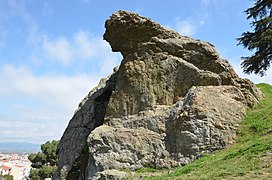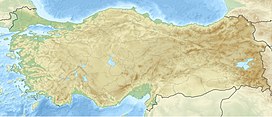| The article's lead section may need to be rewritten. Please help improve the lead and read the lead layout guide. (September 2024) (Learn how and when to remove this message) |
| Mount Spil | |
|---|---|
| Mount Sipylus | |
 The "Weeping Rock" associated with Niobe on Mount Sipylus The "Weeping Rock" associated with Niobe on Mount Sipylus | |
| Highest point | |
| Elevation | 1,513 m (4,964 ft)see section |
| Coordinates | 38°34′02″N 27°27′17″E / 38.56722°N 27.45472°E / 38.56722; 27.45472 |
| Geography | |
 | |
| Geology | |
| Mountain type | Shield volcano |
Mount Spil (Turkish: Spil Dağı), the ancient Mount Sipylus (Ancient Greek: Σίπυλος) (elevation 1,513 m or 4,964 ft), is a mountain rich in legends and history in Manisa Province, Turkey, in what used to be the heartland of the Lydians and what is now Turkey's Aegean Region.
Its summit towers over the modern city of Manisa as well as over the road between İzmir and Manisa. The contiguous mass of Mount Yamanlar, also overlooking the Gulf of İzmir, has often been considered an extension of the Mount Sipylus massif, with which it shares much history, although it is actually an extinct volcano and a distinct geographical formation.
History
The Manisa relief, a full-faced statue carved into a cliff face, is found near Mount Sipylus, several kilometers east of Manisa. According to the Byzantine commentator John the Lydian, the unknown author of the 7th-century BCE epic poem, the Titanomachy, placed the birth of Zeus not in Crete but in Lydia, which should signify Mount Sipylus.
The names "Sipylus" or "Sipylum" are mentioned by Pliny the Elder, supported by other sources, as the site of a very celebrated city called "Tantalis" or "the city of Tantalus", after the name of its founder. Presumably located on or very near the mountain, the city's ruins were reportedly still visible around the beginning of the Common Era.
The same Tantalus is famed throughout Greek mythology thanks to the accounts that he had cut up his son Pelops and served him up as food for the gods. His son Pelops is said to have later migrated to the Peloponnese, named after him, and to have founded a kingdom there. Tantalus' daughter was the tragic Niobe, who is associated with the "Weeping Rock" (Ağlayan Kaya in Turkish), a natural formation facing the city of Manisa. The Greek deities Apollo and Artemis were said to have killed all 14 children of Niobe at Mount Sipylus, whereupon the grief-stricken Niobe was turned to stone.
Later in ancient times, Mount Sipylus (Ancient Greek: Σίπυλος) rose above the site of Magnesia ad Sipylum (the southern portion of modern Manisa), whose existence is traced back as far as the 5th century BCE. Magnesia was located along the Hermus River (Gediz River) on the plain below and was the scene of the defeat of Antiochus III "the Great" by the Romans at the Battle of Magnesia in 190 BCE. The city of Smyrna lay nearby.
Spil today
An important reforestation effort was begun in the 1960s, covering thousands of hectares on and around the mountain. Since then, Spil Dağı National Park has attracted many foreign and domestic tourists. The famous "Weeping Rock" is still widely visited.
The mountain as a whole presents an area of dense forests and is known for its wild tulips. The mountain is also a common spot for camping, parachuting, hiking and other mountain sports.
The motorway connecting the two regional metropolitan centers, İzmir and Manisa, crosses between the two neighboring masses of Mount Sipylus and Mount Yamanlar through the Sabuncubeli Pass, which was much described by ancient travellers and writers and which descends from an altitude of 600 m to sea-level in only a few kilometers. The highest point of the pass corresponds to a point near the boundary between İzmir Province and Manisa Province. To bypass the steep and twisted Sabuncubeli Pass, the 6,480-metre (21,260 ft)-long Sabuncubeli Tunnel was built from 2011 to 2018.
Footnotes
- George Perrot (2007). History of Art in Phrygia, Lydia, Caria and Lycia (in French and English). Marton Press. p. 62. ISBN 978-1-4067-0883-7.
- James George Frazer (2010) . Pausanias, and other Greek sketches, later retitled Pausanias's Description of Greece. Kessinger Publishing Company. ISBN 978-1-4286-4922-4.
- Pseudo-Apollodorus, Bibliotheke, iii.46.
- Quintus Smyrnaeus, i.390ff Theoi.com on-line quotation
- Ovid, Metamorphoses VI.145–310.
- George Maxim Anossov Hanfmann; Jane C. Waldba (1975). A survey of Sardis and the major monuments outside the city walls. Harvard University Press. p. 171. ISBN 978-0674857513.
- Kuşen, Mustafa (2013-07-17). "Sabuncubeli Tüneli uzatılınca açılışı 2016 sonuna kaldı". Zaman (in Turkish). Archived from the original on 2014-04-19. Retrieved 2014-04-18.
- "Sabuncubeli Tüneli Ranta mı Dönüşüyor?". Manisa Manşet (in Turkish). 2013-07-19. Archived from the original on 2014-04-19. Retrieved 2014-04-18.
- "İzmir-Manisa arasını 15 dakikaya indiren Sabuncubeli Tünelleri ulaşıma açıldı". TRT Haber (in Turkish). 2018-06-11. Archived from the original on 2018-07-15.
References
- George E. Bean (1967). Aegean Turkey: An archaeological guide. London: Ernest Benn. ISBN 978-0-510-03200-5.
External links
- Mount Spil National Park. "Information page" (in Turkish). Manisa Directorate of Environment and Forestry. Archived from the original on 2004-08-21. Retrieved 2007-04-03.
- Sheridan, Paul (2015-09-05). "The Locust Plagues of Mount Sipylus". Anecdotes from Antiquity. Retrieved 2015-09-05.
| National parks of Turkey | |
|---|---|
| Aegean region | |
| Black Sea region | |
| Central Anatolia region | |
| Eastern Anatolia region | |
| Marmara region | |
| Mediterranean region, Turkey | |
| Southeastern Anatolia region | |
| Mountains of Turkey | |
|---|---|
| Mountain ranges | |
| Mountains |
|